In the old part of Cuenca there are around 30 churches and I didn’t even try to visit them all, but I did arrange a tour for the next day. The guide, who was also the driver, was named Alfredo and he was extremely pleasant and forthcoming, on top of knowing all kinds of stories about the places we passed or visited.
First we went to the north driving along the Pan-American motorway that stretches from Tierra del Fuego in the south to Alaska in the north and that is cut only in one place – this is in Panama on account of the canal. In Ecuador, it was paved as late as during the 1960s. At one point we passed over a watershed at the altitude of around 3600 m. When the weather is nice it is possible to see the Pacific some 200 km to the west, while towards the east after the sloping of the terrain and across the lower parts that constitute the basin of the Amazon, there is the Atlantic Ocean some 6500 km away. Still, just to clarify, the Pan-American motorway in this section is not a 5-lane motorway or something like that. No, it’s an ordinary road, but certainly one of the main traffic lines in Ecuador. Occasionally there were more cars, but also at a very sharp curve we came across a boy who pulled a rope tied on one side of the road while he stood on the other side, by which he managed to stop the already slow cars. That would give him an opportunity to ask for some money.
After a while we arrived in Alausi. The town itself was not particularly important, but this was the place from which a two-hour wild train ride started. While waiting to get on the train literally, I watched a man making souvenirs out of tagua. Tagua is a very hard white part of a seed of some palms that is also called fake ivory or vegetarian ivory. It is often used for making buttons, but also for small knick-knacks for tourists. I filmed the man make a small pot out of the seed, which I eventually received as a gift, but I also bought a small parrot made of tagua.
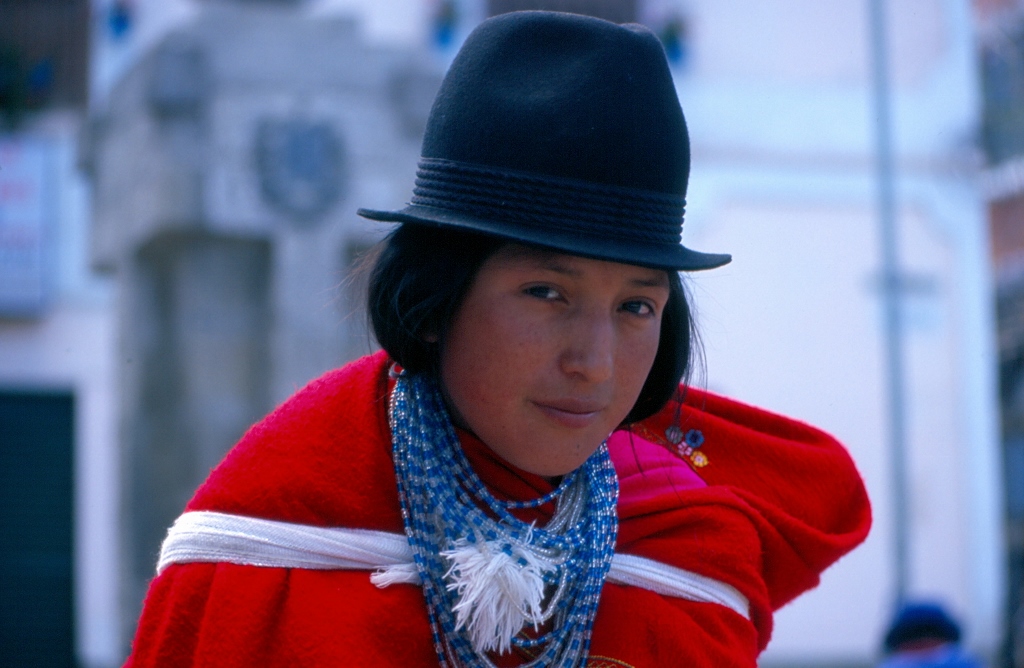 Alausi
Alausi
Still, the main reason for coming to Alausi was that train ride. What makes the whole thing interesting and special is that tourists climb onto the roof of the train and sit there during the entire ride. Well, perhaps some of the elderly tourists got into the train, but the more agile ones climbed on top with great joy. Alfredo advised me to sit on the right-hand side of the train in the direction of moving, since the view was better. The train zigzags downhill and later uphill around a section of a mountain called the Devil’s Nose. To make things even more interesting for tourists, the conductor checking the tickets walked extremely skilfully through the seated tourists while the train moved.
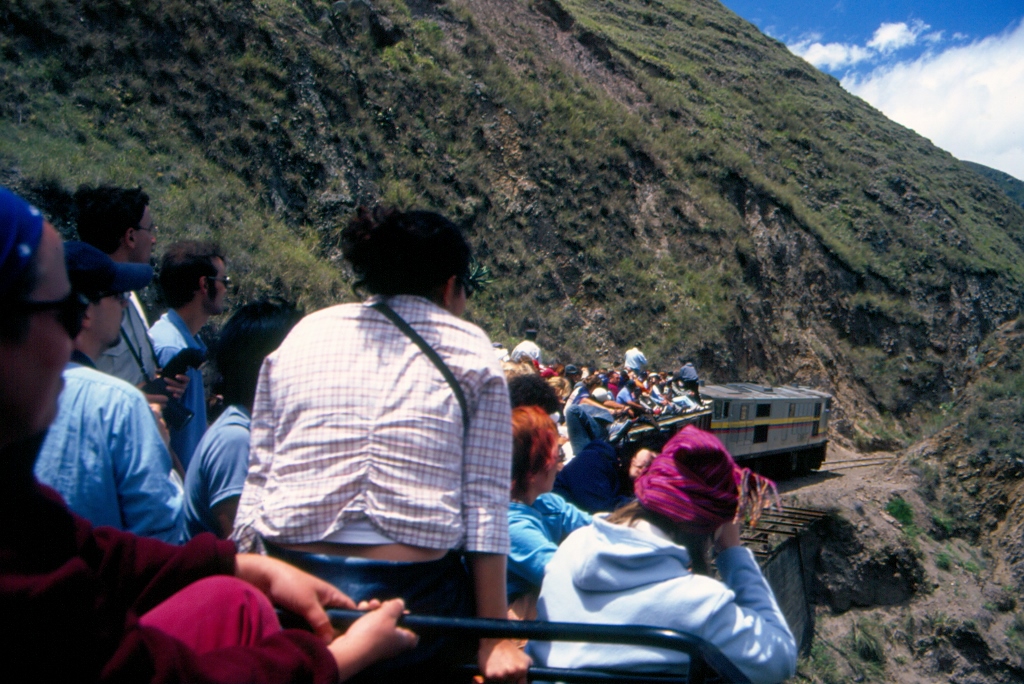 Train ride, Alausi
Train ride, Alausi
After this, Alfredo and I were joined by an elderly couple from England. Together we first stopped for lunch and then continued to Ingapirca.
Ingapirca is an archaeological site discovered in 1970. Most of it used to be buried with only the top of the Temple of the Sun protruding, and then the clearing up and archaeological digging started. These are also the oldest ruins in Ecuador and they are located at 3160 m a.s.l. It is assumed that there used to be a sanctuary of the Cañari tribe, only to be taken over by the Incas. Other than as a sanctuary and the place where the Inca ruler used to stay when coming for a visit, Ingapirca was also used as a strategic stronghold. The Incas were there only for some 100 years, as they occupied the territories of the Cañari tribe, who in turn as revenge helped the Spanish, so it is considered that this is one of the reasons why the Spanish managed to defeat the Incas so easily.
Descendants of the Cañari tribe continue to live in this region and a lot of them cherish their tradition. Among other things, this tradition consists of a white bonnet worn by women. There are no ribbons on the bonnet, but there is a small bell fastened to the rim. When a girl is unmarried, the bell is on the front side and once she gets married, the bonnet is rotated with the bell in the back. It was precisely this kind of bonnet I saw on a girl who guided a group of tourists around Ingapirca.
As an archaeological site, Ingapirca clearly demonstrates such distribution of buildings that creates a puma shape on the ground. The Incas used to plan their settlements in such a way that their ground plan had a shape of a puma, a condor, a llama, etc. In this case the head of the puma is where the Temple of the Sun is located. Other than the Temple of the Sun, there are also remains of premises that were used for storing, the royal palace, buildings for accommodation of messengers and servants who attended to the rulers, the Temple of the Moon, etc. At the very beginning of the site there are buildings that were used for storing food and this is where Alfredo told us how they managed to preserve potatoes. The potatoes were first smashed and then left out in the open. During the day, the sun would dry them out and at night this would be the task of the frost and coldness, so after 11 days of such treatment the potatoes would be ready for storage and could be kept for a dozen of years and still be edible. Out of the former storages there are only foundations remaining and a low wall, but what is interesting is that there seems to be no entrance into the premises!!! The theory is that the entry was positioned higher up, thus providing more storage space and preventing some of the pests from entering.
 Ingapirca
Ingapirca
Talking about walls, there are a lot of low walls around and it is possible to see on them a clear distinction in the masonry of the Cañaris and the Incas. Namely, the Cañaris used untreated stones from rivers, while the Incas worked on their building stone with famous precision. However, they were all very skilful when collecting gold from a nearby river that used to be auriferous. For this purpose, they would take large stones in which they made holes and then put them back into the river. The river would flow over the stones while the pieces of gold would drop into these holes that were checked by the industrious collectors every day.
The main building at the Ingapirca site is the Temple of the Sun. This is the oldest sanctuary of the Incas in Ecuador. The building itself is positioned on a base consisting of 1600 pieces of stone, none of which is the same as any other and yet all perfectly fitted. In this fitting of stones the Incas were unsurpassed and this is truly amazing when you look at it. The Temple, as well as its entrance and windows are of trapezoid shape. This shape helped strengthen the construction of the facility, which was of significant importance in case of an earthquake and there are plenty of those in this region. The Temple consists of two rooms with niches that were used for establishing with the help of the sun the time of the year.
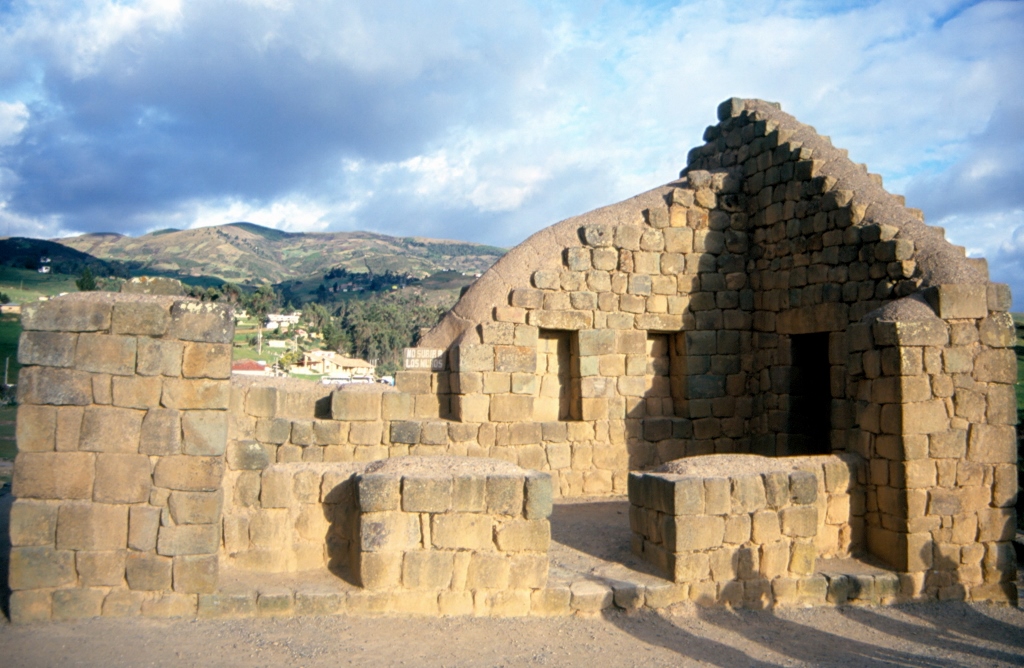 Temple of the Sun, Ingapirca
Temple of the Sun, Ingapirca
The Incas’ rulers came here only occasionally, but the Temple of the Sun was very important. On the basis of the time of the year it was decided which agricultural works had to start, plus the sun was also very important because they believed that their rulers were direct descendents of the Sun. A ruler could be only somebody who was a child of another ruler and his blood sister and no other child of the ruler born out of some other liaison.
As I’ve mentioned, some of the buildings were used for the stay of messengers. It is quite known that the Incas used to have a very good communication system and a very broad network of roads or rather paths. Even today, above Ingapirca, it is possible to see a road made by the Incas that leads further north in the direction of Quito.
After this visit we headed back to Cuenca. Along the way we saw houses the roofs of which had decoration in the shape of sun, moon, birds and eggs, all symbolizing happiness, wellbeing, etc. Women in Ecuador are very hard-working, they carry a lot and work a lot, and a good deal of this can certainly be explained by the fact that their husbands often go abroad to work and wives back home need to do everything. Or there are often cases when both parents go abroad to work, while children are looked after by the grandparents. It is estimated that the money which these migrant workers send back home constitutes the second or third highest revenue of the entire country. Ecuador earns more only from oil and possibly some other commodity the price of which is high in the world market at the given moment.
When we talked about it, this older English couple who were otherwise exceptionally pleasant and kind made a side comment which I didn’t like and which even today makes me regret not reacting to it. Namely, when talking about this income and the money sent for the family left behind in Ecuador to build a decent house or something similar, they said: “Ah, that’s where our money goes!” Alfredo fell silent and I could see he felt very embarrassed, as was I, and I’m still sorry I didn’t reply: “No, this is not where YOUR money goes, but the money these people have earned and saved by working on the jobs your fellow citizens would not do.” I don’t believe that these English people had any bad intention, but I think their comment was out of place and uncalled for.
Along the way we also saw restaurants that had rotating grills, like the ones we use in my country for chickens, but here the skewers were shorter and thicker since the grills were used for guinea pigs. Apparently, since who knows when, guinea pigs have been one of the main culinary specialties that may be found in some parts of the Andes. Even nowadays, their meat is very much appreciated and even more expensive than other types of meat.
The next morning I first walked to a nearby river. Cuenca lies on 4 small rivers, but I could visit only one of them, since I was running out of time. Early that afternoon I had a flight back to Quito. But, before that I managed to walk over to a green-market, which was fabulous. I generally love to visit green-markets and this one was great. There were small kitchen premises around for preparing fresh food and the aromas were seductive. There was a lot of fish and rice, as well as fried bananas, either in chunks or as crisps. I’m not even going to start with fresh fruits and vegetables.
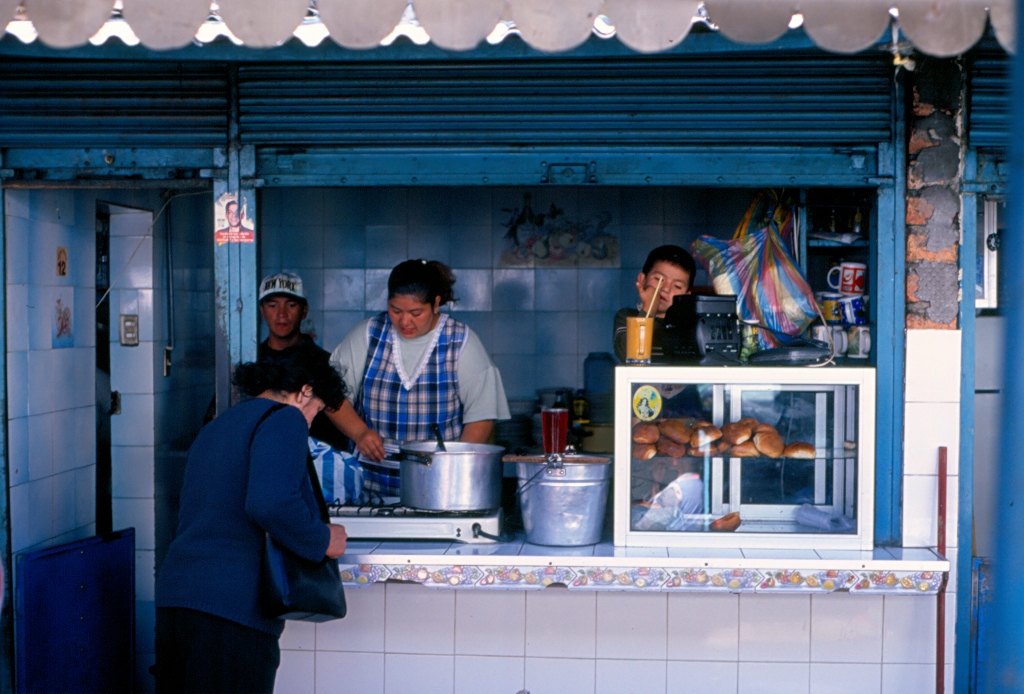 Cuenca green market
Cuenca green market
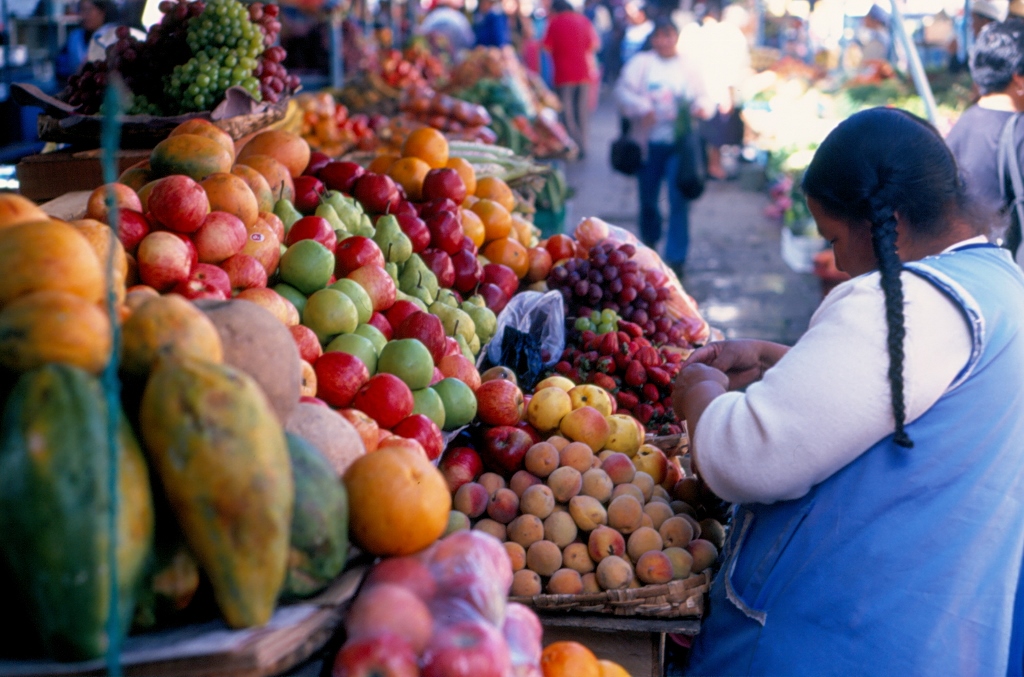 Cuenca green market
Cuenca green market
And yet, the main thing I did that morning was a visit to a factory of panamas. The panamas or Panama hats, contrary to their name, are in fact manufactured in Ecuador and only in Ecuador. The reason behind their name is that they were used on a massive scale by workers building the Panama Canal, but the hats are actually made of a palm-like plant that grows only in Ecuador. This straw hat in its diverse versions has been worn by various film celebrities, members of the world’s jet-set and aristocracy, while the infamous Al Capone could not be even imagined without his panama. Alfredo had referred me to a factory and advised me what to say when I got there, so I ended up with a free private tour of the factory. At the very entrance there was a model of a house in which people in that area used to live in the past. There was also a pretty girl who posed in traditional clothes and imitated weaving of a hat, but after that the tour went around the factory showing different phases in the production. The plant used for the panamas is first washed in water for several days and then it is left to dry in the sun. The straw that is obtained is used for weaving hats and the weavers usually do this in the privacy of their homes, after which the shapeless hats are delivered to the factory. Then, they are dyed, pressed, ironed and decorated. In the past, the panamas used to be shaped manually, but now machines have taken over, so there are numerous moulds on the shelves that are used for pressing in the desired shape. The final products are truly beautiful hats. A man’s panama may cost between 10 and 80 USD, with the higher price meaning that the hat has a denser weave. There are exceptionally chic models, but since I don’t wear hats and still had a lot of travelling to do, I was really in two minds as to what to do. Eventually I went for it and treated myself to a simple model that actually managed to survive till my home where it now lies packed up in a cupboard dreaming of fulfilling its hat’s destiny of being worn sometimes.
Having returned to Quito I met with my friends from the USA and we spent the entire next day searching for an attractive and affordable tour of Galapagos. After a lot of efforts and patience we managed to find something to our liking and it was a truly good piece of advice to book a visit to the Galapagos in Ecuador. Even for the same ship and the same period we came across significantly different prices at different agencies. On the other hand, if one is not flexible with time, this may be a very risky endeavour as there is a danger not to find free places at all.
Be as it may, we ended up with a free day before travelling to the Galapagos and on that day we went for a tour that included a visit to a small town Otavalo which is a couple of hours’ drive to the north of Quito. The town itself is nothing special, but every Saturday it holds a market with locally produced craft, textile, etc., and this market is considered as one of the best in Latin America with a tradition dating back to the pre-Columbian times. Now, it’s mostly a place for tourists that covers over 10 blocks of criss-crossed streets, so that an entire section of the town turns into an open market. There is a smaller market beside it that is obviously not for tourists, for it sells fresh food, but there is also a spacious square where one may eat already prepared food. At several stands we saw a large roasted pig brought in one piece and then slowly cut into smaller chunks that were sold as a part of a complete meal. This is how it goes: the vendor takes a small plastic bag, puts in some boiled seeds, then meat and gravy, finishing it with chopped onions and cabbage. So, an entire meal in a small plastic bag. We happened to be in Otavalo on a market day, which meant a lot of crowds. Since none of us was interested in shopping, we didn’t stay there for long.
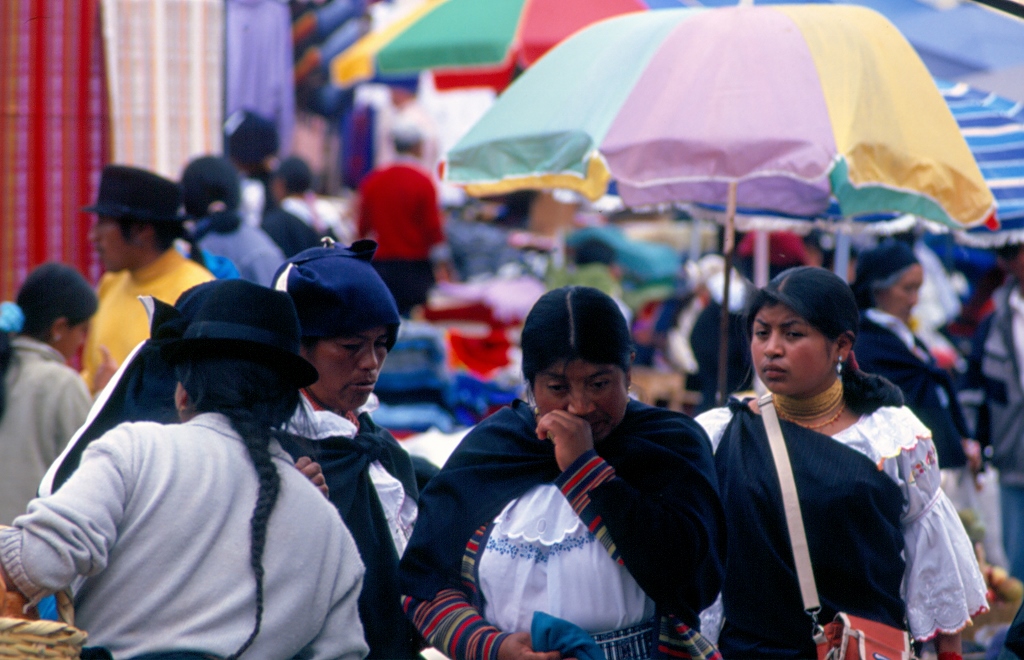 Otavalo
Otavalo
Along the road between Quito and Otavalo, one may see several volcanoes, Cayambe, Imbabura and Cuicocha. As we returned from Otavalo, we stopped by this last one which is 3300 m high in order to visit its crater. Apparently, some 500 years ago, the melting snows filled out its crater thus creating a very pretty lake. There is no fish in the lake, but there are some water birds and the water is beautifully clean and translucent. We walked a little along the interior of the crater and went down to the water edge. Close to this lake, there is a small town Cotacachi in which we came across some festivities taking place in what seemed to be the main square. One person, in some devil-like costume danced to the beat of very loud music leading a long file of people who also danced and stomped behind him. Needless to say, we joined in, but not before trying some sugarcane brandy which was not very strong, but which certainly turned us into great connoisseurs of the local dancing steps.
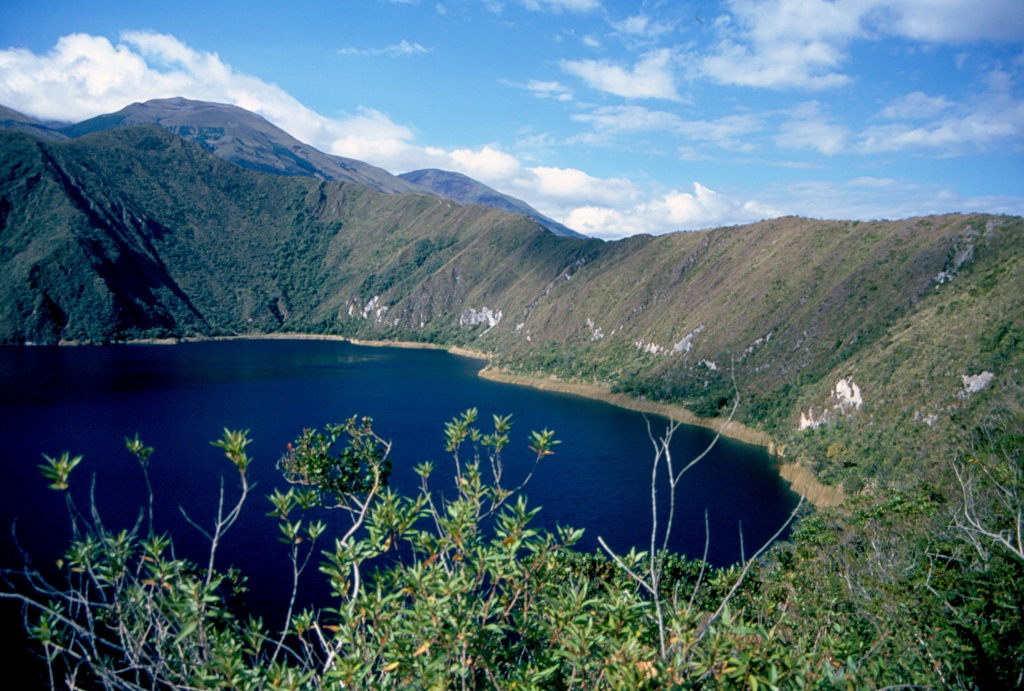 Cuicocha
Cuicocha
The next day we took a flight to the Galapagos. There on the plane I had an opportunity to reaffirm the already set impression that the Ecuadorians are exceptionally nice and kind people. I had a seat next to a woman of my age and we had a blast of a chat. I don’t know her name, she never asked me about mine, but when she got up to leave the plane in Guayaquil, we wished each other all the best and then she, taken by a sudden desire to give me something, took three bead bracelets off her hand and shoved them into mine. To this very day, these bracelets continue to be one of the dearest souvenirs from my travels.